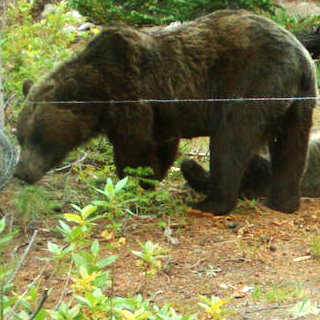Transboundary Publications
The threatened Yaak and Selkirk grizzly bear populations in northern Montana, Idaho, and Washington are integrally linked to populations in Canada and their long-term recovery requires cooperation between the U.S. and Canada. It is recognized that the forces that brought these populations to their threatened status in the U.S. are also operating in Canada. It follows that the solutions will also lie in both countries. To this end, the USFWS entered into a working relationship with Canadian biologist Michael Proctor of Birchdale Ecological Services to enhance recovery efforts between the countries. Proctor works closely with the British Columbian Ministry of Environment to implement a comprehensive recovery program that includes active research, reducing human-caused mortalities, enhancing inter-population movements, increasing public awareness, and augmenting these populations within Canada. Ongoing research projects include a DNA survey and population estimate, identification of linkage zones across Canadian Highway 3 using movement data from grizzly bears wearing GPS radio collars, and a landscape assessment of genetic status. Information gathered by these efforts will be used to prioritize conservation actions and enhance movements of bears between these small threatened populations and larger healthier ones within Canada, a management action that is key to their long-term recovery.
Trans-border Grizzly Bear Project's website
Kasworm, W., H. Carriles, T. Radandt, and C. Servheen. 2005. Cabinet-Yaak Grizzly Bear Recovery Area 2004 Research and Monitoring Progress Report. 69 pp.
Kasworm, W., H. Carriles, T. Radandt and C. Servheen. 2006. Cabinet-Yaak Grizzly Bear Recovery Area 2005 Research and Monitoring Progress Report. U.S. Fish and Wildlife Service, Missoula, Mont. 73pp.
Kasworm, W.F., M.F. Proctor, C. Servheen, and D. Paetkau. 2007. Success of Grizzly Bear Augmentation in Northwest Montana. Journal of Wildlife Management 71(4):1261-1266.
Maguire, L. and C. Servheen. 1992. Integrating biological and sociological concerns in endangered species management: augmentation of grizzly bear populations. Conservation Biology 6: 426-434.
Proctor, M.F. 2003. Genetic analysis of movement, dispersal and population fragmentation of grizzly bears in southwestern Canada. Ph.D. Dissertation, University of Calgary, Calgary, Alberta, Canada. 147 pp.
Proctor, M.F., B.N. McLellan, C. Strobeck, and R.M. R. Barclay. 2005. Genetic analysis reveals demographic fragmentation of grizzly bears yielding vulnerably small populations. Proceedings of The Royal Society B. Published online. 8 pp.
Proctor, M. F., Paetkau, D., Mclellan, B. N., Stenhouse, G. B., Kendall, K. C., Mace, R. D., Kasworm, W. F., Servheen, C., Lausen, C. L., Gibeau, M. L., Wakkinen, W. L., Haroldson, M. A., Mowat, G., Apps, C. D., Ciarniello, L. M., Barclay, R. M. R., Boyce, M. S., Schwartz, C. C. and Strobeck, C. 2012. Population fragmentation and inter-ecosystem movements of grizzly bears in western Canada and the northern United States. Wildlife Monographs, 180: 1–46.
Proctor, M.F., C. Servheen, S.D. Miller, W.F. Kasworm, and W.L. Wakkinen. 2004. A comparative analysis of management options for grizzly bear conservation in the U.S.-Canadian trans-border area. Ursus 15(2):145-160.
Servheen, C. and M. Cross. 2010. Climate change impacts on grizzly bears and wolverines in the Northern U.S. and Transboundary Rockies: Strategies for Conservation. Report on a workshop held Sept. 13-15, 2010 in Fernie, British Columbia. 23pp.
Servheen, C. and M. Cross. 2010. Climate change impacts on wolverines and grizzly bears in the Northern U.S. Rockies: Strategies for conservation. Report on a workshop held Oct. 6-7, 2009. 17pp.
Servheen, C., W.F. Kasworm and T.J. Thier. 1995. Transplanting Grizzly Bears ursus arctos horribilis As a Management Tool - Results from the Cabinet Mountains, Montana, USA. Biological Conservation 7: 261-268.
Wakkinen, W.L. and W.F. Kasworm. 1997. Grizzly bear and road density relationships in the Selkirk and Cabinet-Yaak recovery zones. U.S. Fish and Wildlife Service, Missoula, Mont. 28pp.
Wakkinen, W.L. and W. Kasworm. 2004. Demographics and population trends of grizzly bears in the Cabinet-Yaak and Selkirk Ecosystems of British Columbia, Idaho, Montana, and Washington. Ursus 15(1):65-75.
